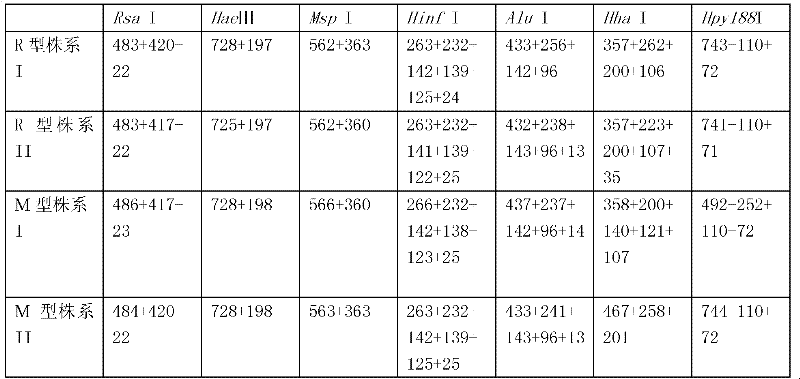PCR-RFLP method for identifying mucronate form of Bursaphelenchus xylophilus and round-tailed form of Bursaphelenchus xylophilus
A PCR-RFLP, pine wood nematode technology is applied in the field of PCR-RFLP identification of M-type and R-type strains of B. xylophilus, and can solve the problem of inability to distinguish M-type and R-type strains of B. xylophilus.
- Summary
- Abstract
- Description
- Claims
- Application Information
AI Technical Summary
Problems solved by technology
Method used
Image
Examples
Embodiment
[0012] 1. DNA extraction: add an appropriate amount of sterilized double distilled water on a sterilized clean glass slide, and use a sterilized No. , II) pick into the water drop, then pick the pine xylophilus into a sterilized 200μl PCR tube containing 8μl double distilled water and 1μl 10×PCRBuffer, centrifuge at 13000rpm for 1min, then place it in liquid nitrogen for 1min and take it out. Immediately place it at a constant temperature at 85°C for 2 minutes, and quickly cool down to 56°C; then add 1 μl of proteinase K solution with a concentration of 1 mg / mL to the PCR tube, keep the PCR tube at a constant temperature of 56°C for 15 minutes, and then keep it at 95°C for 10 minutes to obtain DNA Extraction solution;
[0013] 2. PCR amplification: 50 μl reaction system was used, the upstream primer was 5′-CGT AAC AAG GTA GCT GTA G-3′, and the downstream primer was 5′-TTT CAC TCG CCG TTACTAAGG-3′ (the upstream and downstream primers were purchased from TaKaRa Company ), the a...
PUM
 Login to View More
Login to View More Abstract
Description
Claims
Application Information
 Login to View More
Login to View More - R&D
- Intellectual Property
- Life Sciences
- Materials
- Tech Scout
- Unparalleled Data Quality
- Higher Quality Content
- 60% Fewer Hallucinations
Browse by: Latest US Patents, China's latest patents, Technical Efficacy Thesaurus, Application Domain, Technology Topic, Popular Technical Reports.
© 2025 PatSnap. All rights reserved.Legal|Privacy policy|Modern Slavery Act Transparency Statement|Sitemap|About US| Contact US: help@patsnap.com

